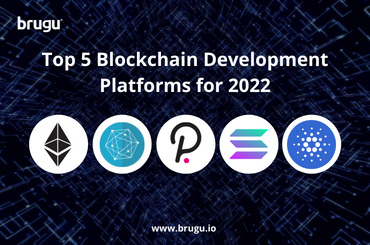The blockchain market is still growing at a breakneck pace. The number of blockchain development platforms is increasing in tandem with the growing interest in blockchain technology, and it might be tough to find the ideal framework to satisfy all of your business demands. In this post, we’ll give you a quick rundown of the best blockchain development platforms in 2022, as well as some pointers on what to look for when selecting a blockchain development company.
Table of contents:
- Ethereum
- Hyperledger Fabric
- Polkadot
- Solana
- Cardano
- How to choose a blockchain platform for your business
- Conclusion
1. Ethereum
The main features: Ethereum is a public open-source platform based on the Proof of Work idea. It gives developers a set of tools to use in order to create blockchain-based solutions in the Ethereum Virtual Machine environment. Ethereum includes its own programming language, Solidity, as well as its own cryptocurrency, Ether, which is used to execute transactions and run programs on the Ethereum network. The market value of one ETH was $2,236 at the end of May 2021, according to the Ethereum Price, making Ether the second most valuable cryptocurrency on the market behind Bitcoin.
Strong and weak points: Its high level of security owing to decentralization, low downtime, adaptability, and large community. Of course, there are flaws in the system. For example, as compared to other platforms, there are lengthy processing times and greater transaction prices, as well as scaling concerns. It’s worth mentioning, however, that the Ethereum team is now troubleshooting. In 2021, for example, the platform teamed up with Polygon, a company that wants to build Ethereum-compatible blockchain networks. In addition, Ethereum is undergoing a redesign known as Ethereum 2.0, which will work on the Proof of Stake (PoS) principle to improve security and scalability while also making Ethereum more accessible.
Use cases: The emergence of DeFi in 2020 and NFT in 2021, both of which are closely tied to Ethereum, has increased demand for the network. The number of Ethereum-based projects available is astounding. Aside from banking, the platform is used to develop voting systems, secure medical data storage, games, and social networks, among other things. The number of effective Ethereum use cases is growing, and Ethereum will be one of the most promising blockchain development platforms in the coming year’s thanks to continual developments.
2. Hyperledger Fabric
The main features: Hyperledger Fabric is a cross-industry blockchain network that lets developers use plug-and-play components to build blockchain-based solutions. The modular architecture is to thank for this. The platform was designed for usage by industrial enterprises and is permissioned, meaning that only authorized users have access to data. Hyperledger Fabric also has ‘chain codes,’ which are smart contracts.
Strong and weak points: Hyperledger Fabric combines the advantages of blockchain technology with improved security and privacy for sensitive data. It provides good performance and scalability, as well as the ability to set up a clear identity management system to regulate who joins the network. This is an example of a blockchain that can be used by businesses that aren’t involved in cryptocurrency projects.
The platform is always becoming better. Hyperledger Fabric 2.0, for example, was launched in January 2020. The update improves data privacy while also ensuring decentralized smart contract management.
Hyperledger Fabric, on the other hand, is not ideal for people seeking transparency. There are minimal use cases for this platform because the market is mostly focused on public blockchains.
Use cases: Hyperledger Fabric allows for private transactions and confidential contracts, making it appropriate for financial institutions that value privacy and security. Other enterprises, including healthcare, government, and supply chain corporations, can use the platform to build their own private blockchain network. HP, Amazon, Visa, Walmart, and more companies have already adopted this technology.
Despite fierce competition in the market, Hyperledger Fabric is one of the most popular solutions for building enterprise blockchains. According to IDC, enterprise blockchain spending in Europe has increased by 60% in the last year, and we can expect continued demand for this blockchain development platform.
3. Polkadot
The main features: Polkadot is a technology that allows for the creation of a multi-blockchain network with completely decentralized information exchange. Developers can establish new blockchains and connect existing ones in this ecosystem. You may use permission data from a private blockchain in a public blockchain thanks to Polkadot’s unique architecture, which supports para chains. It has a good potential of becoming one of the top blockchain development platforms in the coming years because it addresses the issues of blockchain scalability and interoperability.
Strong and weak points: Polkadot offers various advantages to both developers and consumers of blockchain technology. First, the network enables the processing and transmission of data between public and private blockchains in a rapid and safe manner. The platform is really scalable and useful. Second, it provides new potential for decentralized application developers. Polkadot, for example, allows individual blockchains to rely on common security characteristics by offering a single foundation for creating protocols. Polkadot is viewed by many blockchain specialists as a game-changing solution that makes the concept of a unified blockchain network more realistic than before.
Polkadot is a relatively young project, hence there are few use cases to fully understand the technology’s effectiveness. Some criticize it for its lack of decentralization, which is attributed to its reliance on its own DOT currency.
Use cases: Polkadot focuses exclusively on crypto projects, such as DeFi and NFTs. It teamed up with the Chainlink initiative in 2020 to recruit DeFi app developers. Transaction chains, IoT chains, oracle chains, identification chains, data distribution chains, and other types of chains can all be built on the platform. The platform’s popularity is growing, and we’re optimistic that new exciting initiatives in the Polkadot ecosystem are on the way.
Create your own NFT Marketplace on Polkadot Blockchain with Trending Features
4. Solana
The main features: Solana differs from other platforms in a number of ways. There are no sidechains or para chains on this first-level blockchain. The platform is decentralized and open-source. It has its own cryptocurrency, which is known as SOL. Nodes on the Solana blockchain are compensated for processing SOL transactions, and unlike many other blockchains, it does not require a minimum quantity of money to set up a node. Solana employs a new cryptic technique known as Proof of History (PoH). It enables increased scalability and transaction processing speed. Solana’s current throughput, according to representatives from the Solana Foundation, is 60,000 transactions per second.
Strong and weak points: The key benefits of Solana are not limited to transaction speed and cost. The platform also offers exceptional scalability and project compatibility. It also provides a good user experience, which is lacking in many decentralized initiatives.
Because Solana is a relatively new blockchain platform, it has yet to receive significant adoption, and many projects are still in the works. Many functionalities are in test mode, which implies there is a chance of a system crash. Furthermore, some developers argue that the blockchain is not sufficiently decentralized. Despite this, Solana has a lot of potential and numerous advantages over other cryptocurrencies like Ethereum.
Use cases: Although Solana has been on the market for some time, rising interest in NFTs resulted in a significant boom in 2021. Because mining non-fungible tokens on Solana is cheaper and faster than on Ethereum, many users and projects interested in non-fungible tokens have chosen it for further development. There are many of DeFi projects based on Solana, such as wallets, DEXs, and stablecoins. According to various sources, Solana’s ecosystem currently includes approximately 200 enterprises.
In addition, the network is still evolving. The Solana Foundation was established in 2020 to aid in the development of the environment. Solana Labs donated 167 million SOL coins to the foundation in exchange for this. In addition, Solana developers established a cross-chain bridge with Ethereum in October 2020, allowing for asset transfers between the two blockchains.
Launch your Solana-Based NFT Marketplace Platform | Solana NFT Marketplace Development
5. Cardano
The main features: Cardano is a proof-of-stake blockchain platform that is open-source. It has a multi-layered architecture and its own coin, ADA. Cardano is based on the Proof-of-Stake principle, which examines the amount of bitcoin in circulation. Smart contract functionality is available on the platform. The most appealing aspect of Cardano is its decentralized nature. The platform achieved 100 percent decentralization in 2021, and the network now has over 1500 validator pools.
Strong and weak points: Cardano is a powerful and scalable cryptocurrency. Its transactions are speedier and less expensive than the Ethereum network. The ability to make passive income by staking ADA coins is another feature that appeals to users. The platform places a strong emphasis on security. Ouroboros, a Cardano protocol, contains mathematical proof of the system’s permanence even if nodes are offline temporarily owing to a computer failure or power outage, for example. Because of its high decentralization, the system is exceptionally stable.
Cardano is characterized as an “academic blockchain” because it was created after much research and testing. On the one hand, this increases network trust, but on the other hand, it slows down the platform’s development. Much of the criticism stems from this, as the market is very competitive, and the speed with which new ideas arise is critical.
Use cases: Smart contracts, decentralized applications, and sidechains are the main areas of Cardano’s attention. The network also supports NFTs, propelling it to the top of 2021’s blockchains. Cardano is now being used to construct DEXs, NFT marketplaces, stable coins, lending protocols, and other applications.
The Cardano team has a well-defined strategy for upgrading the technologies they employ. The platform is likely to get a number of changes in the near future that will make it an even more appealing option for the creation of blockchain enterprises.
How do you pick a blockchain platform for your business?
Let’s move on to the subject of how to find the proper technological solution for your organization now that we’ve gone over the list of the best blockchain development platforms for 2022. When selecting a blockchain for your project, consider the elements that are crucial to you and that match your business requirements. These elements may include:
Level of confidentiality- If you want to develop an enterprise blockchain but have tight security and privacy needs, you should look into private platforms like Hyperledger Fabric. Choose from the public networks if your company’s purpose is to develop an open initiative with a high level of transparency.
Security- Security is always a concern. Different blockchains use different strategies to ensure that data is securely stored and transmitted.
Decentralization- The advantages of decentralized solutions are being discovered by an increasing number of customers and businesses. Determine the level of decentralization required for your project and the platform that can offer it.
The speed and cost of transactions– Many consumers consider these characteristics when deciding which blockchain applications to utilize. If you choose to work with a platform that has a high gas tax, your development team will have to consider how to make it more efficient.
Scalability- It all depends on your business objectives and the system’s predicted demand. Make sure the platform you choose can handle increasing workloads while maintaining high performance.
The rate of adoption- Finally, while selecting blockchain development solutions. The more popular a platform is, the more users it is likely to attract with less effort. If this is your goal, research the popularity and success of several platforms on the market.
Conclusion:
The blockchain market is growing at a breakneck speed. New and more advanced solutions develop on a regular basis, in addition to updating current ones. When selecting a blockchain development platform for your company, you should consider both the blockchain’s functionality and its track record on the market, because proven solutions offer higher chances for success. In addition, to effectively begin a crypto project, you must not only select the appropriate framework but also identify a development team capable of realizing the technology’s full potential.






